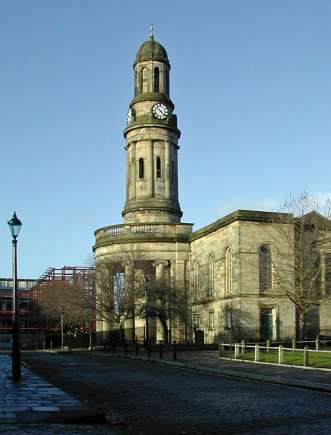Church of St Philip, Salford
Dedicated on St Matthew’s Day (21 September 1925) St Philip’s Church, Salford would probably have been named St Matthew’s had it not been that Dr Bloomfield, the Bishop of Chester, had already promised to consecrate St Matthew’s Camp Field a day or two later, and refused to consecrate two churches with the same dedication. The church, which was one of the many built with the million pound Parliamentary grant voted as a thank offering for the victory at Waterloo, was designed by Sir Robert Smirke, the friend and fellow-traveller of Lord Elgin and the architect of the British Museum. The south side, with its principal doorway placed beneath a portico supported by six massive pillars, and the imposing and dignified, if plain, appearance of the other sides are no bad example of his style. However, the inside of the church has been completely altered since his time, the late Dr Hicks, who was rector for seventeen years having had it restored after designs by Mr Medland Taylor. When the church was built is was meant to serve the double purpose of parish church for a well-to-do residential district and garrison church for the barracks on Regent Road. By the time of Dr Hicks’ appointment a parish which had once been pleasantly suburban, the birthplace of Sir William Agnew, of Mrs Hodgson Burnett, authoress of Little Lord Fauntleroy, and other Salford worthies, had become a crowded industrial area. [Manchester Guardian 12 September 1925 page 13]
Reference Manchester Guardian 24 September 1825 page 2- consecration by Bishop of Chester
Reference Manchester Guardian 12 September 1925 page 13 – centenary
